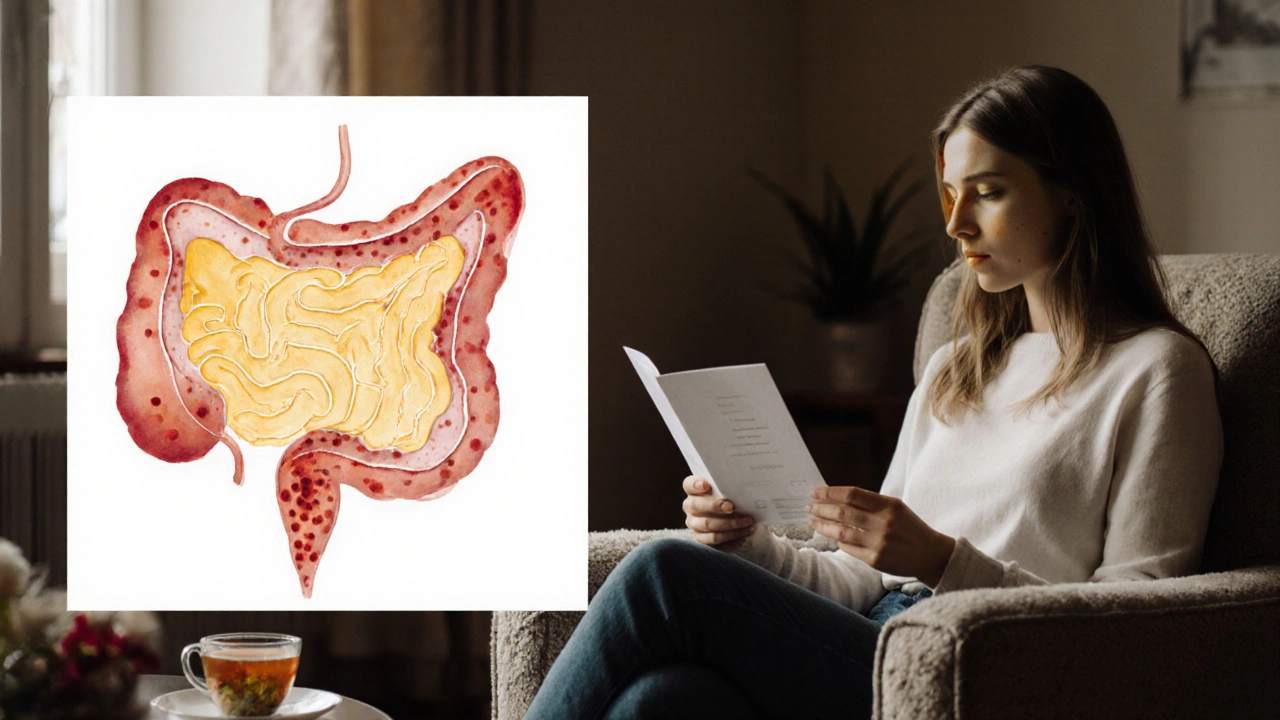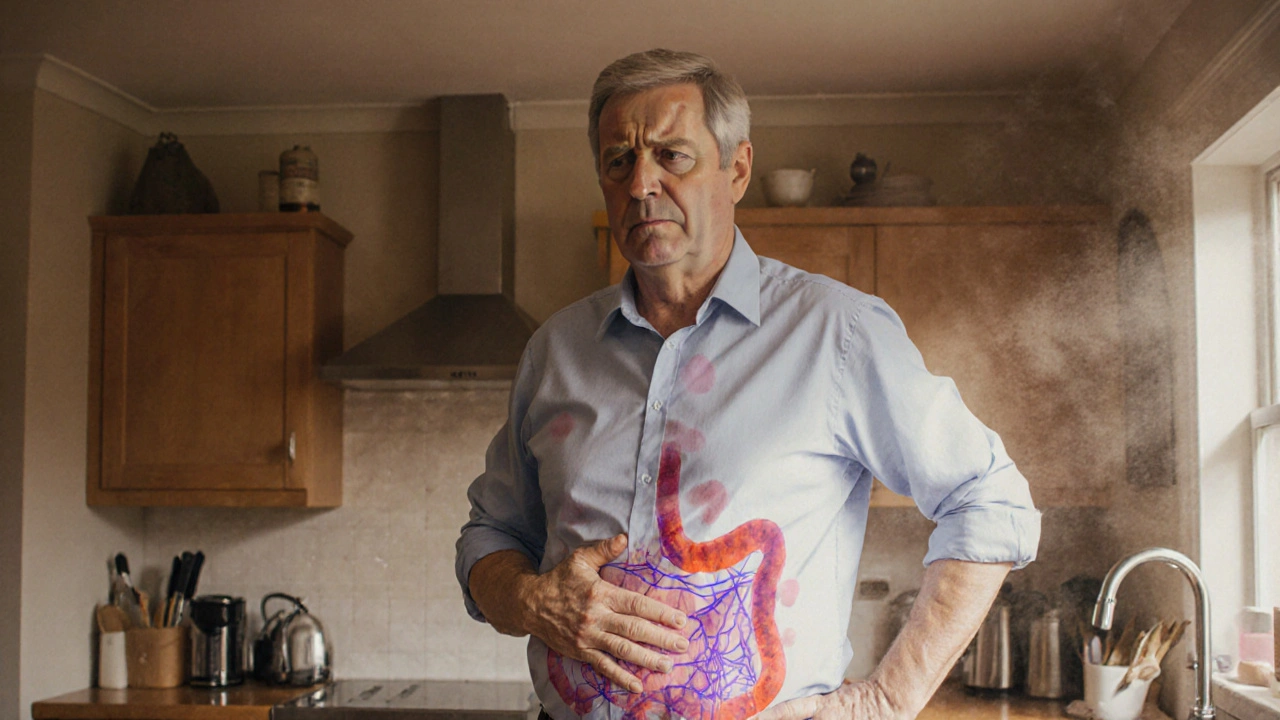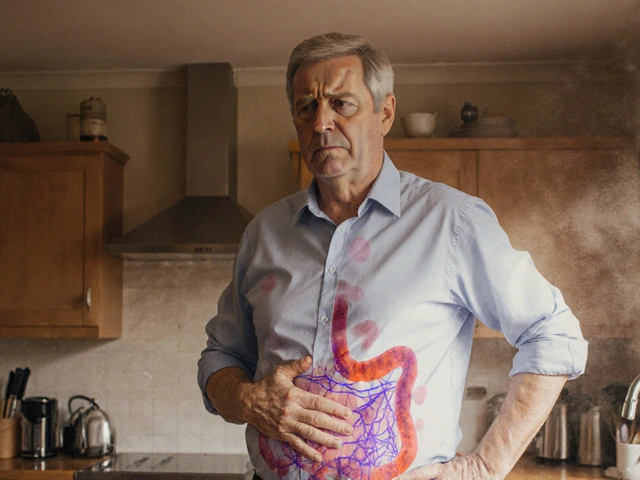Shingles is a viral infection caused by the reactivation of the varicella‑zoster virus that typically appears as a painful rash along a nerve pathway. While most people think of shingles as a skin problem, the virus can also disturb the digestive system, leading to unexpected gut symptoms.
Varicella‑Zoster Virus (VZV) is a DNA virus belonging to the herpesvirus family. After a child contracts chickenpox, VZV retreats to sensory ganglia and can reactivate years later, triggering shingles. The same virus can travel along visceral nerves that supply the gastrointestinal tract, causing inflammation that ripples through the gut.
Gastrointestinal Tract is a continuous tube from the mouth to the anus that digests food, absorbs nutrients, and houses a massive immune network. When VZV reaches the nerves that innervate sections of the GI tract, it can disrupt motility and secretions, leading to abdominal pain, nausea, or diarrhea.
Why Gut Symptoms Appear During a Shingles Outbreak
The connection between shingles and the gut hinges on three biological mechanisms:
- Nerve Inflammation: Reactivated VZV inflames the dorsal root or autonomic ganglia that control gut function. This inflammation can trigger spasm‑like contractions (known as visceral hyperalgesia), mimicking the classic skin‑pain sensations.
- Immune System Disruption: During a shingles flare the immune system diverts resources to fight the virus, temporarily weakening the gut’s local immunity. This opens a brief window for bacterial overgrowth.
- Microbiome Imbalance: Stress hormones and inflammation shift the composition of the Gut Microbiome, the community of trillions of bacteria that aid digestion and regulate immunity. A disturbed microbiome can cause bloating, gas, and irregular bowel movements.
Typical Digestive Signs to Watch For
Not every shingles patient will notice gut trouble, but the most common red flags include:
- Sharp, burning abdominal pain that follows the same dermatome as the rash.
- Unexplained nausea or a loss of appetite.
- Sudden onset of watery diarrhea or constipation that deviates from your normal pattern.
- Excessive gas and bloating that seems unrelated to diet.
If you experience any of these alongside a shingles rash, it’s worth mentioning to your clinician. Early recognition can prevent complications like dehydration or secondary infections.
How Doctors Diagnose Shingles‑Related Gut Issues
Diagnosis is largely clinical, relying on a combination of visual assessment of the rash and a thorough symptom history. Physicians may also order:
- A PCR swab of the blister fluid to confirm VZV DNA.
- Blood tests that show a rise in VZV‑specific IgM antibodies.
- Stool analysis if diarrhea is severe, to rule out bacterial pathogens.
Imaging-such as an abdominal ultrasound-can help exclude other causes of pain but is rarely needed solely for shingles.
Treatment Options That Protect Both Skin and Gut
The cornerstone of shingles care is antiviral therapy, which shortens the outbreak and reduces nerve damage.
Antiviral Medication such as acyclovir, valacyclovir, or famciclovir works by inhibiting viral DNA replication. Starting treatment within 72hours of rash appearance offers the best results.
To soothe gut symptoms, doctors may recommend:
- Hydration with electrolyte‑rich fluids.
- Probiotic supplements (e.g., Lactobacillusrhamnosus) to restore microbiome balance.
- Gentle, low‑fiber meals until inflammation eases.
- Over‑the‑counter anti‑diarrheal agents if diarrhea becomes disruptive, but only under medical advice.
For severe nerve pain, a short course of gabapentin or pregabalin can calm the visceral hyperalgesia, indirectly improving digestive comfort.
Prevention: The Role of Vaccination
One of the most effective ways to keep shingles-and its gut fallout-at bay is vaccination.
Shingles Vaccine (Shingrix) is a recombinant, adjuvanted vaccine that boosts VZV‑specific immunity. Clinical trials show over 90% efficacy in adults over 50, dramatically cutting the risk of reactivation.
Getting the vaccine not only reduces the chance of a rash but also lowers the odds that dormant virus will travel along visceral nerves, preserving gut health.

Lifestyle Steps to Support Your Gut During an Outbreak
Even with medication, everyday habits can make a big difference:
- Stay hydrated: Aim for at least eight glasses of water a day, more if you have diarrhea.
- Eat soothing foods: Bone broth, plain oatmeal, and bananas are easy on the stomach.
- Limit irritants: Cut back on alcohol, caffeine, and spicy foods until pain subsides.
- Manage stress: Practices like deep breathing or gentle yoga can calm the nervous system, reducing gut flare‑ups.
Comparison: Skin‑Only Shingles vs. Shingles with Gut Involvement
| Aspect | Skin‑Only Shingles | Shingles with Gut Involvement |
|---|---|---|
| Primary Manifestation | Localized rash and dermatomal pain | Rash plus abdominal pain, nausea, or diarrhea |
| Nerve Type Affected | Somatic sensory nerves | Visceral autonomic nerves |
| Complication Risk | Post‑herpetic neuralgia | Dehydration, microbiome disruption, prolonged pain |
| Treatment Emphasis | Antivirals & topical pain relief | Antivirals + gut‑supportive measures (probiotics, diet) |
When to Seek Immediate Medical Attention
If any of the following occur, call your doctor or head to an urgent care center:
- High fever (above 101°F) that persists.
- Severe, unrelenting abdominal pain.
- Persistent vomiting or inability to keep fluids down.
- Blood in stool or stool that looks black and tar‑like.
- Signs of an allergic reaction to medication (hives, swelling).
Next Steps for Readers
Now that you know how shingles can affect your gut, you can act proactively. Schedule a vaccine appointment if you’re over 50, keep a symptom journal during any outbreak, and talk to your healthcare provider about adding probiotics or gut‑friendly diets to your treatment plan.
Frequently Asked Questions
Can shingles cause diarrhea?
Yes. When VZV reactivates in nerves that supply the intestines, inflammation can speed up transit, leading to watery stools. The effect is usually temporary and improves with antiviral therapy and hydration.
Do I need a different antiviral dose if I have gut symptoms?
Standard dosing works for most people. However, if you’re unable to keep pills down because of nausea, your doctor may switch to an IV formulation to ensure the virus is still suppressed.
How long do gut symptoms last after the rash clears?
Gut discomfort can linger for a few days to a couple of weeks, depending on how severe the nerve inflammation was. Supporting the microbiome with probiotics often shortens this period.
Is the shingles vaccine safe for people with chronic digestive diseases?
Clinical data show the vaccine is well‑tolerated even in patients with inflammatory bowel disease or celiac disease. Talk to your gastroenterologist beforehand to coordinate timing with any other treatments.
Can stress trigger shingles in the gut?
Stress weakens immune surveillance, increasing the chance that dormant VZV will reactivate. Managing stress therefore reduces the risk of both skin and gut manifestations.









Amy Elder September 26, 2025
Stay hydrated and trust your gut to heal.
Erin Devlin September 27, 2025
The body whispers when the virus walks the nervous highways, reminding us of fragility.
Raghav Narayan September 28, 2025
When shingles reactivates, the varicella‑zoster virus can travel along autonomic fibers that innervate the gastrointestinal tract, leading to a cascade of inflammatory signals.
These signals disrupt the coordinated peristaltic waves, producing either hypermotility with diarrhea or hypomotility with constipation.
In addition, the immune system’s focus on viral clearance temporarily reduces local gut immunity, creating an environment conducive to bacterial overgrowth.
The resulting dysbiosis further amplifies symptoms such as bloating, gas, and abdominal discomfort.
Clinicians should therefore consider both dermatologic and gastrointestinal findings when evaluating a patient with shingles.
Standard antiviral therapy-acyclovir, valacyclovir, or famciclovir-remains the cornerstone, and early initiation within 72 hours limits neuronal damage.
Supportive care for the gut includes oral rehydration solutions rich in electrolytes to counteract fluid loss.
Probiotic supplementation, especially strains like Lactobacillus rhamnosus, can help restore microbial balance during and after the outbreak.
Low‑residue, easily digestible foods such as bananas, oatmeal, and bone broth reduce mechanical irritation of the inflamed gut wall.
Patients experiencing severe nausea may benefit from anti‑emetic agents, but these should be prescribed under supervision to avoid masking warning signs.
For persistent visceral pain, a short course of gabapentin or pregabalin can dampen nerve hyperexcitability, indirectly easing gut symptoms.
It is also advisable to avoid alcohol, caffeine, and spicy foods until the inflammatory phase subsides.
Vaccination with Shingrix dramatically lowers the risk of reactivation and consequently reduces the likelihood of gut involvement.
For individuals with chronic gastrointestinal conditions, coordinating vaccination timing with their gastroenterologist ensures optimal safety.
Overall, a multidisciplinary approach that addresses both the viral infection and the secondary gut effects yields the best patient outcomes.
Lindy Fujimoto September 29, 2025
Wow, that was a marathon of medical wisdom 🧠💥-feels like reading a textbook on steroids 😂🌟.
darren coen September 29, 2025
Exactly, the gut really does feel the ripple when nerves go haywire.
Jennifer Boyd September 30, 2025
Love how the science meets self‑care – keep those probiotics handy and your spirits higher!
Lauren DiSabato October 1, 2025
While the thoroughness is commendable, the average reader might drown in the minutiae; a concise summary would suffice.
Hutchins Harbin October 1, 2025
Look, the grammar in that long post is solid, but consider breaking up the walls of text – readability matters as much as accuracy.
luemba leonardo brás kali October 2, 2025
Indeed, splitting the content into digestible paragraphs enhances comprehension for a broader audience.
Corey McGhie October 2, 2025
Oh great, another lecture on probiotics – as if we don’t already have a million brands staring at us on the shelves.
Ajayi samson October 3, 2025
Honestly the whole vaccine hype is a manufactured panic, they’re just looking to cash in on fear.
Lief Larson October 4, 2025
Culture matters when talking about gut health, different cuisines bring unique microbes to the party
Julia Grace October 5, 2025
Super helpful tip on bone broth – it’s like a warm hug for the belly, and the probiotics are the confetti on the party!
Jennifer Pavlik October 6, 2025
Remember to keep a simple food diary during an outbreak; it makes spotting patterns easier.
Jacob Miller October 7, 2025
Seriously, a diary? That’s basic self‑care for anyone with a functioning brain.
Anshul Gandhi October 8, 2025
The mainstream narrative hides the truth about hidden pharmaceutical agendas, and the vaccine is just the tip of the iceberg.
Emily Wang October 9, 2025
Let’s stay focused on real solutions: proper hydration, balanced diet, and staying active even when feeling low.